
Flushing Meadows–Corona Park, often referred to as Flushing Meadows Park, or simply Flushing Meadows, is a public park in the northern part of Queens in New York City, New York, U.S. It is bounded by I-678 on the east, Grand Central Parkway on the west, Flushing Bay on the north, and Union Turnpike on the south. Flushing Meadows–Corona Park is the fourth-largest public park in New York City, with a total area of 897 acres (363 ha).

The 1964–1965 New York World's Fair was a world's fair that held over 140 pavilions and 110 restaurants representing 80 nations, 24 U.S. states, and over 45 corporations with the goal and the final result of building exhibits or attractions at Flushing Meadows–Corona Park in Queens, New York City. The immense fair covered 646 acres (2.61 km2) on half the park, with numerous pools or fountains, and an amusement park with rides near the lake. However, the fair did not receive official support or approval from the Bureau of International Expositions (BIE).

The Mets–Willets Point station is a rapid transit station on the IRT Flushing Line of the New York City Subway. Located near the Citi Field baseball stadium, it is served by the 7 train at all times and by the express <7> train rush hours in the peak direction or after sporting events. This station is located near Flushing Meadows–Corona Park in Willets Point, Queens, on Roosevelt Avenue between 114th and 126th Streets.

The 111th Street station is a local station on the IRT Flushing Line of the New York City Subway, located at the intersection of 111th Street and Roosevelt Avenue. It is served by the 7 train at all times.

The Junction Boulevard station is an express station on the IRT Flushing Line of the New York City Subway, located at the intersection of Junction Boulevard and Roosevelt Avenue in Corona, Queens. It is served by the 7 train at all times and by rush hour peak-direction <7> express service.

The Queensboro Plaza station is an elevated New York City Subway station at Queens Plaza in the Long Island City neighborhood of Queens. It is near the east end of the Queensboro Bridge, with Queens Boulevard running east from the plaza. The station is served by the 7 and N trains at all times, the W train on weekdays, and the <7> train rush hours in the peak direction.

The 82nd Street–Jackson Heights station is a local station on the IRT Flushing Line of the New York City Subway, located at the intersection of 82nd Street and Roosevelt Avenue in Jackson Heights, Queens. It is served by the 7 train at all times.

The 69th Street station is a local station on the IRT Flushing Line of the New York City Subway. Located at 69th Street and Roosevelt Avenue in the Woodside, Queens, it is served by the 7 train at all times.

The Queens Zoo is an 18-acre (7.3 ha) zoo located in Flushing Meadows–Corona Park in Queens, New York City. The zoo is part of an integrated system of four zoos and one aquarium managed by the Wildlife Conservation Society in partnership with the New York City Department of Parks and Recreation, and is accredited by the Association of Zoos and Aquariums (AZA).
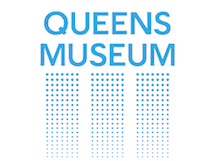
The Queens Museum, formerly the Queens Museum of Art, is an art museum and educational center located in Flushing Meadows–Corona Park in the borough of Queens in New York City, United States. The museum was founded in 1972, and has among its permanent exhibitions, the Panorama of the City of New York, a room-sized scale model of the five boroughs originally built for the 1964 New York World's Fair, and repeatedly updated since then. It also has a large archive of artifacts from both the 1939 and 1964 World's Fairs, a selection of which is on display.

Queens Botanical Garden is a botanical garden located at 43-50 Main Street in Flushing, Queens, New York City. The 39-acre (16 ha) site features rose, bee, herb, wedding, and perennial gardens; an arboretum; an art gallery; and a LEED-certified Visitor & Administration Building. Queens Botanical Garden is located on property owned by the City of New York, and is funded from several public and private sources. It is operated by Queens Botanical Garden Society, Inc.
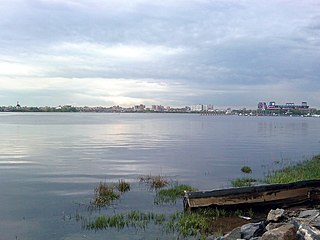
Flushing Bay is a tidal embayment in New York City. It is located on the south side of the East River and stretches to the south near the neighborhood of Flushing, Queens. It is bordered on the west by LaGuardia Airport and the Grand Central Parkway, on the south by Northern Boulevard, and on the east by the neighborhood of College Point. The Flushing River empties into the bay at its southeast corner. A 150-foot-wide navigational channel (46 m) dredged at a depth of 14 feet (4.3 m) runs along much of the bay's length.

The Flushing River, also known as Flushing Creek, is a waterway that flows northward through the borough of Queens in New York City, mostly within Flushing Meadows–Corona Park, emptying into the Flushing Bay and the East River. The river runs through a valley that may have been a larger riverbed before the last Ice Age, and it divides Queens into western and eastern halves. Until the 20th century, the Flushing Creek was fed by three tributaries: Mill Creek and Kissena Creek on the eastern bank, and Horse Brook on the western bank.

Terrace on the Park is a banquet hall in Flushing Meadows–Corona Park in Queens, New York City. The building was constructed by the Port Authority of New York and New Jersey to serve as the heliport for the 1964 New York World's Fair. The building was designed by chief architect Allan Gordon Lorimer, engineers John Kyle and Ray Monte, and planning chief E. Donald Mills.
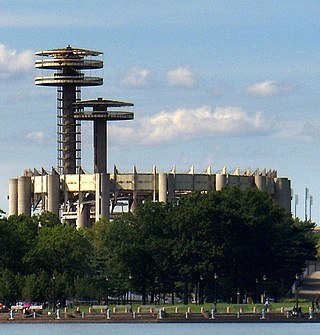
The New York State Pavilion is a pavilion at Flushing Meadows–Corona Park in Queens, in New York City, New York, U.S. It was designed in 1962 for the 1964 New York World's Fair by architects Philip Johnson and Richard Foster, with structural engineer Lev Zetlin. The pavilion consists of three reinforced concrete-and-steel structures: the Tent of Tomorrow, observation towers, and Theaterama. It is owned by the New York City Department of Parks and Recreation and listed on the National Register of Historic Places.

Queens Theatre, formerly Queens Theatre in the Park and before that Queens Playhouse, is an American professional theatre, located in Flushing Meadows–Corona Park, Queens, New York City, New York. Artistic and Executive Directors have included Joseph S. Kutrzeba, founder and producer; Robert Moss, Sue Lawless, Jeffrey Rosenstock and Ray Cullom, formerly Managing Director of Long Wharf Theatre in New Haven, CT, and currently, Taryn Sacramone, former Executive Director of Astoria Performing Arts Center.
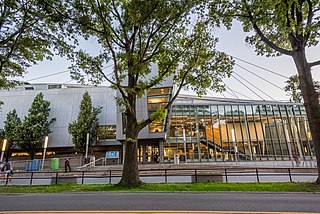
The Flushing Meadows Corona Park Aquatics Center and Ice Rink, also known as the Flushing Meadows Corona Park Aquatics Center or Flushing Meadows Natatorium, is a 110,000-square-foot (10,000 m2) facility in Flushing Meadows-Corona Park, Queens, New York City, with an Olympic-sized pool and an NHL-standard rink. Built in 2008, the $66.3 million project is the first indoor public pool to open in New York City in four decades. Initially, the building was intended to serve as the venue for water polo events during the 2012 Summer Olympics, but when the city's bid was lost to London, the New York City Department of Parks and Recreation proceeded to build the pool anyway. The result is an innovative building with 130-foot-high twin masts and a swooping roof form. The masts are an architectural feature extending up into the Queens skyline as well as the structural supports for the cable-stayed roof. This design provides the clear spans necessary to house an Olympic swimming pool along with an ice skating rink.

College Point Fields is a public park in College Point, Queens, New York City. It is bounded by Ulmer and 130th Streets to the west, 23rd Avenue to the north, Linden Place to the east, and 26th Avenue and the remains of Mill Creek to the south. The park contains two fields each for Little League Baseball and regular baseball; a soccer field; a roller hockey rink; and bleachers.

The Q58 and Q58 Limited are bus routes that constitute a public transit line operating primarily in Queens, New York City, with its southern terminal on the border with Brooklyn. The Q58 is operated by the MTA New York City Transit Authority. Its precursor was a streetcar line that began operation in November 1899. and was known variously as the Flushing–Ridgewood Line, the Corona Avenue Line, and the Fresh Pond Road Line. The route became a bus line in 1949.
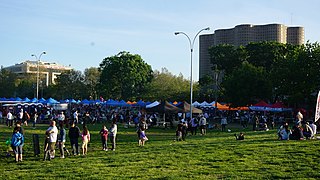
The Queens Night Market, also known as the Queens International Night Market, is New York City's first open-air space inspired by the Asian night market phenomenon. The event launched in Flushing Meadows-Corona Park in Queens in April 2015, with 40 vendors. Since then, it operates on Saturday nights from April through October. As of 2019, the event averages over 10,000 visitors on Saturday nights.


























